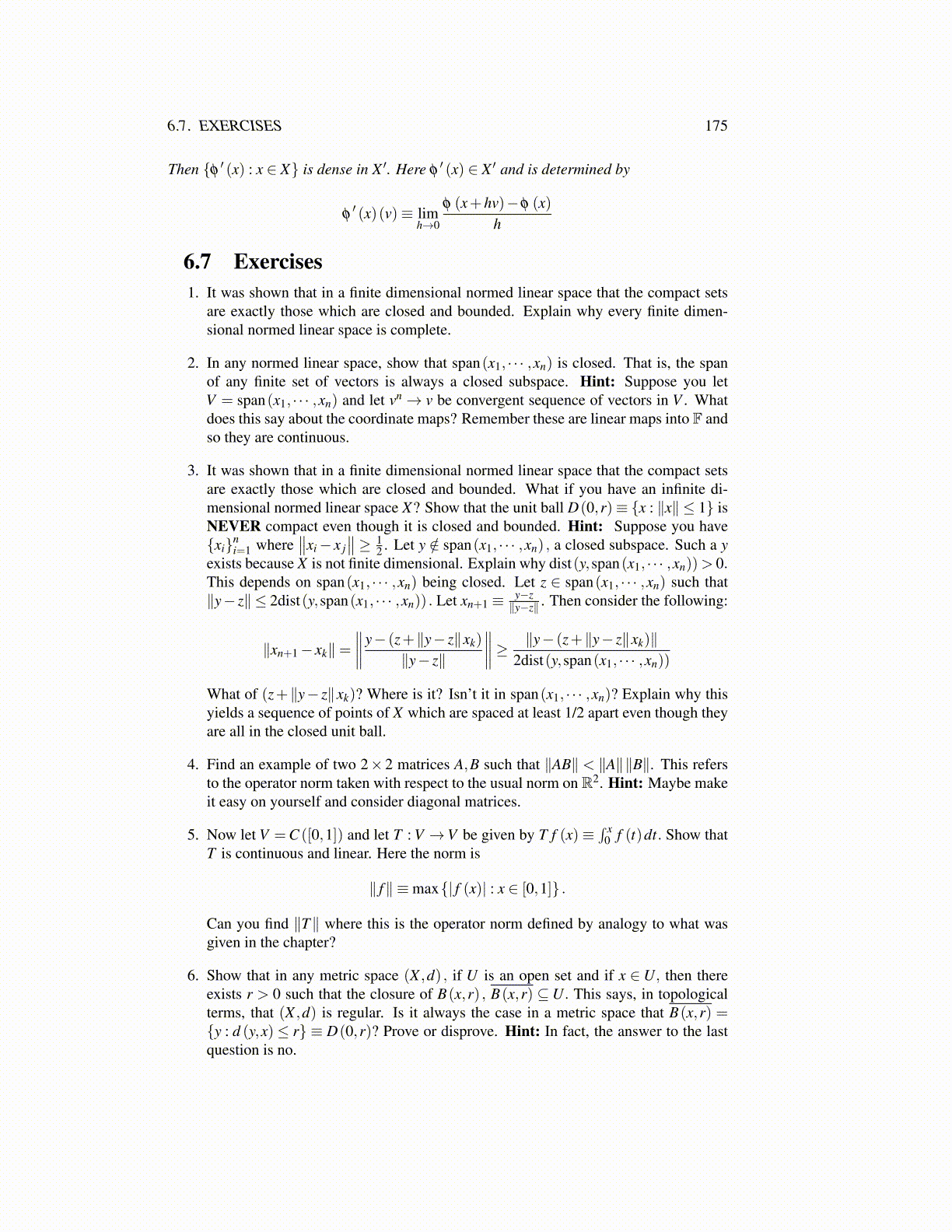
6.7. EXERCISES 175
Then {φ ′ (x) : x ∈ X} is dense in X ′. Here φ′ (x) ∈ X ′ and is determined by
φ′ (x)(v)≡ lim
h→0
φ (x+hv)−φ (x)h
6.7 Exercises1. It was shown that in a finite dimensional normed linear space that the compact sets
are exactly those which are closed and bounded. Explain why every finite dimen-sional normed linear space is complete.
2. In any normed linear space, show that span(x1, · · · ,xn) is closed. That is, the spanof any finite set of vectors is always a closed subspace. Hint: Suppose you letV = span(x1, · · · ,xn) and let vn→ v be convergent sequence of vectors in V . Whatdoes this say about the coordinate maps? Remember these are linear maps into F andso they are continuous.
3. It was shown that in a finite dimensional normed linear space that the compact setsare exactly those which are closed and bounded. What if you have an infinite di-mensional normed linear space X? Show that the unit ball D(0,r)≡ {x : ∥x∥ ≤ 1} isNEVER compact even though it is closed and bounded. Hint: Suppose you have{xi}n
i=1 where∥∥xi− x j
∥∥ ≥ 12 . Let y /∈ span(x1, · · · ,xn) , a closed subspace. Such a y
exists because X is not finite dimensional. Explain why dist(y,span(x1, · · · ,xn))> 0.This depends on span(x1, · · · ,xn) being closed. Let z ∈ span(x1, · · · ,xn) such that∥y− z∥ ≤ 2dist(y,span(x1, · · · ,xn)) . Let xn+1 ≡ y−z
∥y−z∥ . Then consider the following:
∥xn+1− xk∥=∥∥∥∥y− (z+∥y− z∥xk)
∥y− z∥
∥∥∥∥≥ ∥y− (z+∥y− z∥xk)∥2dist(y,span(x1, · · · ,xn))
What of (z+∥y− z∥xk)? Where is it? Isn’t it in span(x1, · · · ,xn)? Explain why thisyields a sequence of points of X which are spaced at least 1/2 apart even though theyare all in the closed unit ball.
4. Find an example of two 2× 2 matrices A,B such that ∥AB∥ < ∥A∥∥B∥. This refersto the operator norm taken with respect to the usual norm on R2. Hint: Maybe makeit easy on yourself and consider diagonal matrices.
5. Now let V =C ([0,1]) and let T : V →V be given by T f (x)≡∫ x
0 f (t)dt. Show thatT is continuous and linear. Here the norm is
∥ f∥ ≡max{| f (x)| : x ∈ [0,1]} .
Can you find ∥T∥ where this is the operator norm defined by analogy to what wasgiven in the chapter?
6. Show that in any metric space (X ,d) , if U is an open set and if x ∈U, then thereexists r > 0 such that the closure of B(x,r) , B(x,r) ⊆U. This says, in topologicalterms, that (X ,d) is regular. Is it always the case in a metric space that B(x,r) ={y : d (y,x)≤ r} ≡ D(0,r)? Prove or disprove. Hint: In fact, the answer to the lastquestion is no.